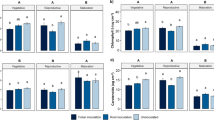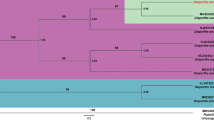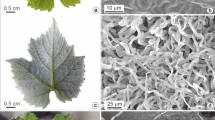Abstract
By transversely cutting infected avocado plant stems and using PCR techniques on avocado leaves, two experiments were carried out to determine whether Rosellinia necatrix can invade avocado vascular tissues. We were unable to detect the pathogen in either stems or leaves in either experiment, so we concluded that R. necatrix does not invade the vascular system of the plant. Additionally, the toxins produced by the pathogen were also studied to determine whether such toxins could contribute to the wilting and death of avocado plants infected by R. necatrix, having an effect on avocado leaves, where they can hinder the photosynthetic process. First, we isolated and identified the toxins cytochalasin E and rosnecatrone from filtrates of six R. necatrix isolates. Second, we tried to detect cytochalasin E in sap and leaves from infected avocado plants, and it was not detected at the minimum level of 50 μg/kg in leaves or 25 μg/kg on sap. Finally, we observed changes in fluorescence emitted by the avocado leaf surface (to detect photosynthetic efficiency) after inoculating avocado plants with this toxin. Fluorescence was higher in the leaves of plants immersed in toxin solution after 4 and 8 days, but not after longer periods of time. In this work, we demonstrated that although R. necatrix is not a fungus that invades the vascular system, its toxins are probably involved in the wilting and death of infected avocado plants, decreasing the efficiency of photosynthesis.



Similar content being viewed by others
References
Andolfi, A., Mugnai, L., Luque, J., Surico, G., Cimmino, & Evidente, A. (2011). Phytotoxins produced by fungi associated with grapevine trunk diseases. Toxins, 3, 1569–1605.
Atkins, S. D., & Clark, I. M. (2004). Fungal molecular diagnostics: a mini review. Journal of Applied Genetics, 45, 3–15.
Bilger, W., & Björkman, O. (1990). Role of the xanthophyll cycle in photoprotection elucidated by measurements of light-induced absorbancy changes, fluorescence and photosynthesis in leaves of Hedera canariensis. Photosynthesis Research, 25, 173–185.
Blomquist, C., Irving, T., Osterbauer, N., & Reeser, P. (2005). Phytophthora hibernalis: a new pathogen on rhododendron and evidence of cross amplification with two PCR detection assays for Phytophthora ramorum. Plant Health Progress. doi:10.1094/PHP-2005-0728-01-HN.
Doyle, J. J., & Doyle, J. L. (1987). A rapid DNA isolation procedure for small quantities of fresh leaf tissue. Phytochemistry Bulletin, 19, 11–15.
Edwards, R. L., Maitland, D. J., & Whalley, A. J. S. (1989). Metabolites of the higher fungi. Part 24. Cytochalasin N, O, P, Q and R. New cytochalasins from the fungus Hypoxylon terricola Mill. Journal of the Chemical Society, Perkin Transactions, 1, 57–65.
Edwards, R. L., Maitland, D. J., Scowen, I. J., de Sousa, A. J. T., & Whalley, A. J. S. (2001). Metabolites of the higher fungi. Part 32. Rosnecatrone, a phytotoxic bicyclo (4, 1, 0) hept-3-en-2-one from the fungus Rosellinia necatrix Prill. Journal of the Chemical Society. Perkins Transactions, 1, 537–542.
Foissner, I., & Geoffrey, O. W. (2007). Wide-ranging effects of eight cytochalasins and Latrunculin a and B on intracellular motility and actin filament reorganization in Characean Internodal cells. Plant Cell Physiology, 48, 585–597.
Freeman, S., & Sztejnberg, A. (1992). Rosellinia. In L. L. Singleton, J. D. Mihail, & C. M. Rush (Eds.), Methods for research on Soilborne Phytopathogenic fungi (pp. 71–73). St. Paul, MN, USA: APS Press.
French, E. R. & Hebert, T. T. (1980). Métodos de investigación fitopatológica. Instituto Interamericano de Ciencias Agrícolas.
Granum, E., Pérez-Bueno, M. L., Calderón, C. E., Ramos, C., de Vicente, A., Cazorla, F. M., & Barón, M. (2015). Metabolic responses of avocado plants to stress induced by Rosellinia necatrix analysed by fluorescence and thermal imaging. European Journal of Plant Pathology, 142, 625–632.
Grimmer, M. K., Foulkes, M. J., & Pavelei, N. D. (2012). Foliar pathogenesis and plant water relations: a review. Journal of Experimental Botany, 63, 4321–4331.
Kanematsu, S., Hayash, T., & Kudo, A. (1997). Isolation of Rosellinia necatrix mutants with impaired cytochalasin E production and its pathogenicity. Annals of the Phytopathological Society of Japan, 63, 425–431.
López, M., Ruano-Rosa, D., López-Herrera, C. J., Monte, E., & Hermosa, R. (2008). Intraspecific diversity within field isolates of Rosellinia necatrix in south-East Spain. European Journal of Plant Pathology, 121, 201–205.
López-Herrera, C. J. (1998). Hongos de suelo en el cultivo del aguacate (Persea americana Mill.) del litoral andaluz, V Jornadas Andaluzas de Frutos Tropicales. Junta de Andalucía: Consejería de Agricultura y Pesca.
López-Herrera, C. J., & Melero-Vara, J. M. (1992). Diseases of avocado caused by soil fungi in the southern Mediterranean coast of Spain, In Proceedings of the Second World Avocado Congress, 1991 (pp. 119–121). USA: California.
López-Herrera, C. J., & Zea-Bonilla, T. (2007). Effects of benomyl, carbendazim, fluazinam and thiophanate methyl on white root rot of avocado. Crop Protection, 26, 1186–1192.
Martínez-Ferri, E., Zumaquero, A., Ariza, M. T., Barceló, A., & Pliego, C. (2015). Non-destructive detection of white root rot disease in avocado rootstocks by leaf chlorophyll fluorescence. Plant Disease, 1, 49–58.
Maxwell, K., & Johnson, G. (2000). Chlorophyll fluorescence: a practical guide. Journal of Experimental Botany, 51, 659–668.
Murashige, T., & Skoog, F. (1962). A revised medium for rapid growth and bio-assays with tobacco tissue cultures. Physiologia Plantarum, 15, 473–497.
Ofon, A. U., & Pearce, R. B. (1991). Toxin production by Rosellinia desmazieresii (Berk. & Br.) Sacc. European Journal of Plant Pathology, 21, 57–63.
Pliego, C., Kanematsu, S., Ruano-Rosa, D., de Vicente, A., López-Herrera, C., Cazorla, F. M., & Ramos, C. (2009). GFP sheds light on the infection process of avocado roots by Rosellinia necatrix. Fungal Genetics and Biology, 46, 137–145.
Pliego-Alfaro, F. (1988). Development of an in vitro rooting bioassay using juvenile-phase stem cuttings of Persea americana mill. Journal of Horticultural Science, 63, 295–301.
Ruano-Rosa, D., Schena, L., Ippolito, A., & López-Herrera, C. J. (2007). Comparison of conventional and molecular methods for the detection of Rosellinia necatrix in avocado orchards in southern Spain. Plant Pathology, 56, 251–256.
Ruano-Rosa, D., Del Moral Navarrete, L., & López-Herrera, C. J. (2010). Selection of Trichoderma spp. isolates antagonistic to Rosellinia necatrix. Spanish Journal of Agricultural Research, 8, 1084–1097.
Santos, L., Azebedo, J. L., Pereira, J. O., Carneiro, M. L., & Labate, C. A. (2000). Symptomless infection of banana and maize by endophytic fungi impairs photosynthetic efficiency. New Phytology, 147, 609–615.
Schena, L., & Ippolito, A. (2003). Rapid and sensitive detection of Rosellinia necatrix in roots and soils by real time scorpion-PCR. Journal of Plant Pathology, 85, 15–25.
Schena, L., Nigro, F., & Ippolito, A. (2002). Identification and detection of Rosellinia necatrix by conventional and real-time scorpion-PCR. European Journal of Plant Pathology, 108, 355–366.
Steel, R. G. D., & Torrie, J. H. (1960). Principles and practice of statistics with special reference to the biological sciences. New York, USA: McGraw Hill Book Co.
Sztejnberg, A., & Madar, Z. (1980). Host range of Dematophora necatrix, the cause of white root rot disease in fruit trees. Plant Disease, 64, 662–664.
Teixeira de Sousa, A. J., Guillaumin, J. J., Sharples, G. P., & Whalley, A. J. S. (1995). Rosellinia necatrix and white root rot of fruit trees and other plants in Portugal and nearby regions. Mycologist, 9, 31–33.
Wang, X. J., Tang, C. L., Chen, J. L., Buchenaeur, H., Zhao, J., Hang, Q. M., Huang, L. L., & Kang, Z. S. (2009). Detection of Puccinia striiformis in latently infected wheat leaves by nested polymerase chain reaction. Journal of Phytopathology, 157, 490–493.
Whalley, A. J. S. (1996). The xylariaceous way of life. Mycological Research, 100, 897–922.
Acknowledgments
This research was supported by the “Consejería de Innovación, Ciencia y Empresa” Junta de Andalucía grant (Grupo PAIDI AGR-235) and by the Plan Nacional I + D + I from Ministerio de Ciencia e Innovación (AGL 2011-030354-CO2-02). In addition, this research was co-financed by FEDER funds (EU).
The authors thank Prof. Anthony J.S. Whalley (Liverpool John Moores University, School of Pharmacy and Biomolecular Sciences, UK) and Prof. Dereck Maitland (Bradford University, UK) for their support to the first author in learning the techniques of toxin purification.
Author information
Authors and Affiliations
Corresponding author
Rights and permissions
About this article
Cite this article
Arjona-Girona, I., Ariza-Fernández, T. & López-Herrera, C.J. Contribution of Rosellinia necatrix toxins to avocado white root rot. Eur J Plant Pathol 148, 109–117 (2017). https://doi.org/10.1007/s10658-016-1074-8
Accepted:
Published:
Issue Date:
DOI: https://doi.org/10.1007/s10658-016-1074-8




